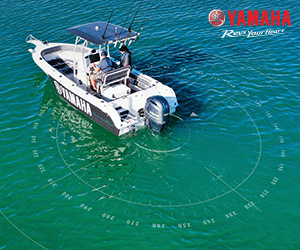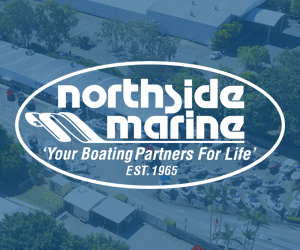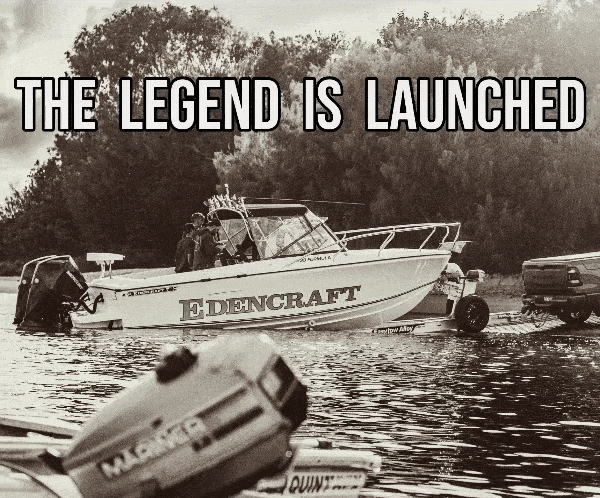Setting up a tinnie Pt 2 – Clayton Nicholls – Feb 14
We left off last time with the boat, a new Stessco Catcher sf 430, fitted out with lighting. The previous article also covered the safety gear that was required for the boat and extra gear I put in for that added peace of mind along with hard mounted accessories such as bilge pumps.
This month we will be looking into mounting and choosing a great depth sounder/ charter plotter combo, wiring everything to a switch board and making extra storage by extending the casting deck and adding a rod locker. Finally there were a few chances to hit the water, break the outboard in, test the Water Snake electric out and catch some fish!
Electronics
After much debate and thought I decided to go with a Lowrance elite 7 hdi. This unit is packed full of features such as the hybrid dual imaging transducer that spits out down imaging and traditional sonar all at once, giving you a clear understanding of the area you’re fishing in. The elite 7 hdi also, as the name suggests, comes with a large 7 inch easy to read screen for those boating moments when multi-tasking is a must and a big screen makes it easy to do so. The sounder also comes with a built in GPS and a Navionics xl9 Gold card to give a great understanding of the water system you are fishing in! The sounder was easy to mount on the wide gunwale; all that was needed was to mark out the brackets position and cut out a hole for the wires to come though the gunwale. The cables then come out from under the bracket to hook up to the sounder, making this a very clever and neat design. The next stage of mounting the sounder combo was to install the transducer. I grabbed out my spirit level and marked the level line on the transducer plate that comes standard on the boat. After marking the line and finding how deep the transducer has to go in accordance with the instructions, a few simple holes and supplies screws were all it took to secure the transducer in place.
By making a side panel between the side pockets and gunwale that can be pulled down it allowed for an easy and neat way to use switch boards and a very neat looking finish to the side of the boat. To wire up the boat and save running power cables everywhere, I utalised buss bars. These bars are rated to a high amperage and allow for one positive and one negative cable running to your battery. The buss bars then have several mounting points, in my case twelve, to attach many positive wires to and the negative bar has an equal amount. The switch boards were all wired up to the bus bar and allowed for many things to be wired up such as the LED lights under the gunwales and the bilge and sounder. I also added a twelve volt socket that can be switched on and off to allow for mobile phone and camera charging on long trips or various other twelve volt devices. The Blueline switch boards were the switch boards of choice, as they have an LED back light and little stickers to place over the lights to denote what is hooked up to that switch. The back of the boards also come pre-fused with a spare fuse in each wire too.
Half way testing
After all the electrical work was complete and the motor was hooked up I took it down to the river to give it a test run to make sure everything worked before continuing on with the casting deck construction. The test day was scorching hot and the fishing wasn’t as good as we had hoped, but a few nice ones were still pulled in. The main aim for the day was to run the motor in and test the sounder and other electronics out. The lights under the gunwales lit the boat up like day and made it very easy for night fishing or even finding gear once you’re home at night!
Casting deck/storage
The casting deck was all pre-marked on the floor in chalk, making it easy to understand where to build and what each compartment was going to be for. I started to make the frame out of 3mm aluminum angle for strength and this allowed three people to stand on it all at once with no problems at all. Once the top and bottom of the design was made, the angle support uprights where riveted in place making it an extremely sturdy and strong frame to work with. The next step was measuring out where the hatches and covering would go. This was done using cardboard and a sharp knife to get an exact fit. After the templates were made, a mathematics compass was used to mark off 7mm all the way around the templates to allow for the carpet. Once this was done and cut out the templates were transferred onto marine ply board and cut out with a jigsaw.
Carpeting and fitting the ply board was the next stage and this was the hardest part of the process, getting those flush finishes from the carpet. After some research and some trial and error, the easiest way I found was to put the wood on the carpet and trace it, flip the wood onto each side and trace that to get the height of the wood. Then draw on angled flaps where it will be secured and cut the entire pattern out. The carpet was then secured to the ply board using a staple gun and a lot of pulling. Once all the ply board was covered it was a simple matter of self-tapping screws and some nylon hinges. The hinges are great because they have a lot of give and if flexed the wrong way or twisted for some reason they just go back to how they were instead of bending to that shape like the metal ones. The nylon hinges also don’t hit the bank account hard like the metal ones either.
Finishing test
As I picked up my mates and headed to Corio Bay the rod locker came in handy to store everyone’s rods, even on the road trip out, and the hatches were incredibly handy to put everyone’s bags in. Once we launched into Fishing Creek it was straight down with the electric motor to fish the snags before heading over to the rocky points for some soft plastic fishing. Once we were at the point, we used the electric to move around from patch to patch and flick plastics and ended up scoring a heap of honeycomb cod, a few dart, some stripeys and a big bream – not bad for a spot I had never fished before. There were also a lot of fish dropped that even the Stella and Omen Black combo couldn’t handle, as they swam straight for the rocks! While fishing, I took notice of the room and for a boat that will probably only see two people at a time using it and having three on it for this trip, it did fantastic. There was lots of leftover storage space, even with three people onboard and the casting deck was able to be used by three people at once and still not feel cramped. The floor space was all clean, because everything was stored under the hatches.
This boat fit out is done, but like every other boat on the water, it is not entirely complete; there is always one more thing you can add/modify on a boat!





